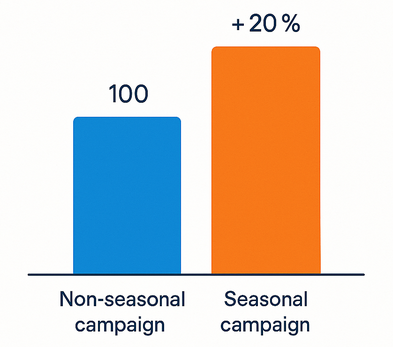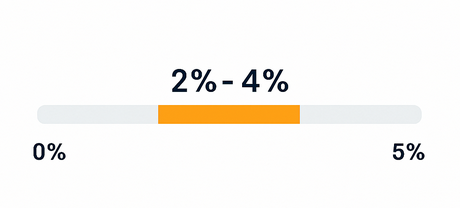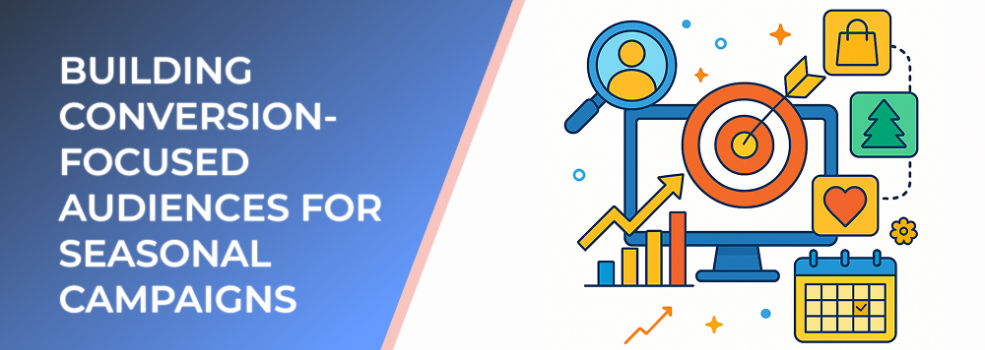Seasonal campaigns can unlock some of the highest conversion opportunities of the year. Whether it's holiday shopping, back-to-school, or industry-specific peak moments, success often depends on how precisely you define and activate your target audiences. With competition intensifying during these periods, understanding user behavior, intent, and timing becomes essential.
Why Seasonal Audience Targeting Matters
Seasonal periods typically bring significant shifts in user activity. For example, retail search volume can increase by more than 30% during major holidays, while customer acquisition costs often rise due to heightened ad competition. Yet, brands that refine their seasonal audiences tend to see stronger returns. According to industry data, targeted seasonal campaigns can boost conversions by up to 20% compared to always-on targeting.

Seasonal campaigns deliver about a 20% uplift in conversion rate compared with non-seasonal campaigns
A well-built seasonal audience helps ensure your message reaches people who are more likely to act during the promotional window, reducing wasted spend and improving relevance.
Key Elements of Seasonal Audience Building

Average e-commerce conversion rate benchmarks in 2025: approximately 2-4% across industries
1. Analyze Historical Seasonal Performance
Understanding past seasonal behavior offers a solid starting point for audience creation.
Look at:
-
Which customer segments converted during previous seasonal cycles
-
Pages with the highest seasonal engagement
-
Seasonal bestsellers or most engaged categories
Historical insights can reveal high-intent groups that resurface year after year.
2. Segment by Seasonal Intent Signals
Intent becomes more predictable during seasonal peaks. Consumers often show clear patterns of:
-
Comparing similar products
-
Adding items to wishlists
-
Searching for discounts
-
Visiting product pages repeatedly within short timeframes
Setting up audiences based on these intent-driven behaviors helps narrow down users who are actively preparing to buy.
3. Use Recency Windows to Capture Hot Prospects
During seasonal campaigns, recency becomes a decisive factor. Data shows that users who interacted with a product in the last 7 days convert at nearly twice the rate of those who engaged 30 days ago.
Shorter recency windows create more "warming" audiences, ideal for high-intent, time-sensitive promotions.
4. Build Audiences Based on Seasonal Lifecycle
Every seasonal campaign has stages. Creating audiences for each ensures relevance throughout the lifecycle.
-
Teaser Phase: Visitors browsing category pages or previous seasonal offers
-
Launch Phase: Users who recently visited specific product pages
-
Peak Phase: Cart abandoners, repeat visitors, and price-checking users
-
Last-Chance Phase: Discount seekers, wishlist users, and returning shoppers
Each stage offers distinct behavioral triggers that can refine audience quality.
5. Reactivate Previous Seasonal Buyers
Past seasonal customers are high-value targets. Studies show that returning seasonal shoppers convert 60% more often than first-time buyers.
Create segments based on:
-
Last year's buyers
-
Subscribers who opened previous seasonal emails
-
Users who purchased complementary products before
These groups are primed for targeted messaging and cross-selling.
6. Test Multiple Seasonal Micro-Segments
Seasonal trends can shift rapidly, making segmentation experimentation critical.
Try creating micro-segments such as:
-
Frequent visitors during the same season last year
-
Users from high-value regions
-
Visitors showing discount-seeking behaviors
-
Shoppers repeatedly browsing gift-related content
Testing multiple variations helps identify which seasonal triggers convert best.
Optimizing Creative and Messaging for Stronger Conversions
Once your seasonal audiences are defined, the next step is tailoring messaging to align with their motivations. Seasonal urgency, scarcity messaging, and personalized recommendations tend to drive significantly higher engagement.
Personalized seasonal ads have been shown to increase CTR by up to 28% compared to generic messages. Aligning creative with the audience's stage in the seasonal lifecycle ensures maximum impact.
Measuring Success and Iterating
Seasonal campaigns operate on compressed timelines, so continuous optimization is essential.
Key metrics to monitor:
-
Conversion rate by audience segment
-
Cost per acquisition (CPA)
-
Return on ad spend (ROAS)
-
Recency-based performance differences
Real-time adjustments help capture the highest possible value before the seasonal window closes.
Final Thoughts
Seasonal campaigns present unique challenges but also unmatched potential for revenue growth. Building conversion-focused audiences allows marketers to reach people at the right moment with the right message. By leveraging historical data, behavioral insights, and lifecycle patterns, campaigns can achieve stronger relevance and significantly higher conversions.

